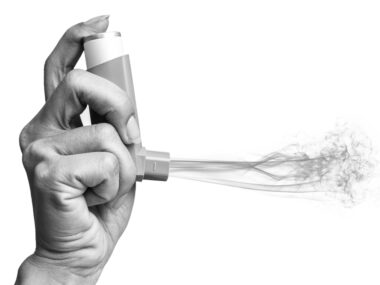Low climate-impact inhalers as effective as pressurized ones: Study
Large study finds no difference in COPD, asthma outcomes
Written by |

Dry-powder corticosteroid inhalers, or those designed to have a low impact on climate, are as effective as those based on pressurized, metered doses at reducing the risk of poor outcomes in people with both chronic obstructive pulmonary disease (COPD) and asthma.
A large study in Denmark found the two inhalers posed comparable risks for hospitalizations because of exacerbations (sudden symptom worsening) or pneumonia, the need for additional corticosteroids, and death.
Inhaled corticosteroids are a standard treatment for both COPD and asthma, two inflammatory lung conditions, and the study’s findings indicate “there is no sign of a clinical benefit which could justify the climate footprint caused by high climate impact inhalers,” the scientists wrote.
The study, “Effect of low climate impact vs. high climate impact inhalers for patients with asthma and COPD-a nationwide cohort analysis,” was published in Respiratory Research.
In COPD, the airways become chronically blocked, leading to symptoms including a persistent cough, wheezing, and shortness of breath. The condition is mainly caused by long-term tobacco smoking, but air pollution and genetics can also be involved.
Inhalers for asthma
Asthma is marked by airway inflammation, shortness of breath, and cough. But unlike COPD, which worsens over time, asthma symptoms are often triggered by allergens, and typically appear as short-term exacerbations that can be quickly resolved with treatment.
Both conditions “can be treated with inhaled corticosteroids (ICS) delivered by low climate impact inhalers (dry powder inhalers) or high climate impact inhalers (pressurized metered-dose inhalers),” the researchers wrote. Inhalers help ease lung inflammation, thereby improving breathing.
Metered-dose inhalers use pressurized canisters to propel a selected dose of medicine into the lungs. Dry powder inhalers don’t use propellants and are delivered to the lungs by breathing in a deep, fast breath.
Hydrofluorocarbon gases are the propellants used in metered-dose inhalers. When released into the atmosphere after use, they are potent greenhouse gases, a type of gas that raises the earth’s surface temperature. Greenhouse gases produced by human activity are major drivers of climate change.
“High climate impact inhalers … [cause] a climate footprint approximately 20 times larger” than low climate-impact inhalers, the researchers wrote.
But there is limited evidence about the effect and risk profile of inhaled corticosteroids delivered by the two types of inhalers for people with both COPD and asthma.
Danish registries provided data
To fill this knowledge gap, an international team led by scientists at the University of Copenhagen analyzed data from several Danish registries and databases. They compared one-year data from 2,535 COPD and asthma patients using low climate-impact inhalers with those of 2,535 COPD and asthma patients using high climate-impact inhalers, matched for several demographic and clinical measures.
Matching variables included age, sex, tobacco exposure, exacerbations, shortness of breath, body mass index (a ratio of height and weight), lung function, inhaled corticosteroid dose, and registry entry year.
Researchers assessed a combined primary outcome of in-patient hospitalization due to exacerbations and mortality from all causes. They found that treatment with metered-dose corticosteroid inhalers was not associated with a lower or higher risk of the combined primary outcome compared with dry powder corticosteroid inhalers.
There were also no significant differences between inhaler types in terms of risk of secondary outcomes, including exacerbations needing hospitalization, all-cause mortality, hospitalization with pneumonia, or all-cause admissions.
However, the use of metered-dose inhalers was linked with a 10% significantly increased risk of exacerbations needing prescriptions for prednisolone, an oral corticosteroid, but no hospitalization relative to dry powder inhalers. The clinical relevance of this result remains “uncertain,” the researchers wrote.
The team also tested the claim that metered-dose inhalers may be a better choice for patients with very low lung function, classified as forced expiratory volume in one second (FEV1) below 30% of predicted. FEV1 measures the amount of air that can be forced out of the lungs in a second.
Again, there were no significant differences in the primary combined outcome between the two types of inhalers.
The team also conducted a sensitivity analysis considering the matching variables across 10,947 patients with COPD and asthma. Among them, 9,785 were treated with inhaled corticosteroids and 1,162 patients were not in the year before study entry.
Again, the type of inhaler had no significant effect on the primary outcome. Older age, being a female, smoking history, exacerbations requiring hospitalization in the year before study entry, worse shortness of breath, and lower FEV1 were significantly linked to an increased risk of hospitalization due to exacerbations or death.
Inhaled corticosteroids “delivered by low and high climate impact inhalers do not have different effect or safety profiles, even among patients with low pulmonary function,” the researchers concluded. “Evidence-based decision-making should consider both patient outcomes and environmental considerations in inhaler selection.”







